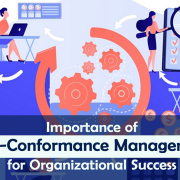Common Non-Conformances in Manufacturing
In the realm of manufacturing, non-conformances represent a critical challenge that can significantly impact product quality, operational efficiency, and overall business success. A non-conformance occurs when a product, process, or system deviates from established specifications or standards. This deviation can arise from various sources, including human error, equipment malfunction, or inadequate processes.
The implications of non-conformances are far-reaching; they can lead to increased costs, wasted resources, and diminished customer satisfaction. As industries strive for excellence in quality management, understanding and addressing non-conformances becomes paramount. The manufacturing sector is characterized by its complexity and the interdependence of various components within the production process.
Each stage, from raw material procurement to final assembly, is susceptible to potential failures that can result in non-conforming products. The challenge lies not only in identifying these non-conformances but also in implementing effective strategies to manage and rectify them. This necessitates a comprehensive approach that encompasses rigorous quality control measures, employee training, and the integration of advanced technologies.
By fostering a culture of continuous improvement and accountability, manufacturers can mitigate the risks associated with non-conformances and enhance their operational resilience.
Key Takeaways
- Non-conformances in manufacturing refer to any deviation from specified requirements or standards in the production process.
- Non-conformance management software is crucial for identifying, documenting, and resolving issues to ensure product quality and compliance.
- Documentation errors and inconsistencies can lead to non-conformances, highlighting the need for accurate and thorough record-keeping.
- Material defects and non-conforming parts can result in product failures and safety hazards, emphasizing the importance of rigorous inspection and testing.
- Equipment and tooling issues can contribute to non-conformances, underscoring the need for regular maintenance and calibration to prevent production disruptions.
Importance of Non-Conformance Management Software
In an era where digital transformation is reshaping industries, non-conformance management software has emerged as an indispensable tool for manufacturers. This software facilitates the systematic tracking, analysis, and resolution of non-conformances throughout the production lifecycle. By automating processes that were once manual and prone to error, such software enhances efficiency and accuracy in identifying deviations from quality standards.
Furthermore, it provides a centralized platform for documenting non-conformances, enabling teams to collaborate effectively and share insights across departments. The benefits of implementing non-conformance management software extend beyond mere compliance; they encompass improved decision-making capabilities and enhanced visibility into quality metrics. For instance, real-time data analytics allow manufacturers to identify trends in non-conformances, enabling proactive measures to address recurring issues before they escalate.
Havteq’s non-conformance management software integrates with other enterprise systems, such as Enterprise Resource Planning (ERP) and Manufacturing Execution Systems (MES), creating a seamless flow of information that supports informed decision-making. As a result, organizations can not only respond to non-conformances more effectively but also foster a culture of quality that permeates every aspect of their operations.
Documentation Errors and Inconsistencies
- Documentation plays a pivotal role in the manufacturing process, serving as the backbone for quality assurance and compliance. However, errors and inconsistencies in documentation can lead to significant non-conformances. These discrepancies may arise from various factors, including miscommunication among team members, lack of standardized procedures, or inadequate training on documentation practices.

- For example, if a production batch record is incomplete or inaccurately filled out, it may result in the release of products that do not meet quality specifications. Moreover, documentation errors can have cascading effects throughout the supply chain. When suppliers or subcontractors receive incorrect specifications or instructions due to poor documentation practices, they may produce components that are incompatible with the final product.
- This not only leads to increased costs associated with rework or scrap but also jeopardizes customer trust and satisfaction. To mitigate these risks, manufacturers must prioritize robust documentation practices that include regular audits, standardized templates, and comprehensive training programs for employees involved in documentation processes.
Material Defects and Non-Conforming Parts
- Material defects are among the most common sources of non-conformances in manufacturing. These defects can stem from various factors, including subpar raw materials, improper handling during storage or transportation, or flaws introduced during the manufacturing process itself. For instance, if a batch of steel used in production contains impurities or does not meet specified tensile strength requirements, it can compromise the integrity of the final product.
- Such material defects not only lead to immediate quality issues but can also result in long-term repercussions if undetected. Addressing material defects requires a multifaceted approach that encompasses rigorous supplier evaluation and selection processes, as well as stringent incoming inspection protocols. Manufacturers must establish clear criteria for assessing the quality of raw materials and components before they enter the production line.
- Additionally, implementing statistical process control (SPC) techniques can help identify variations in material quality over time, allowing manufacturers to take corrective actions before defects propagate through the production process. By fostering strong relationships with suppliers and investing in quality assurance measures, manufacturers can significantly reduce the incidence of material-related non-conformances.
Equipment and Tooling Issues
- The reliability of equipment and tooling is crucial for maintaining consistent product quality in manufacturing. Equipment failures or tooling issues can lead to significant non-conformances by introducing variability into the production process. For example, if a CNC machine experiences a calibration error or a tool becomes worn beyond acceptable limits, it may produce parts that do not conform to specified tolerances.
- Such issues not only result in defective products but can also disrupt production schedules and increase operational costs. To mitigate equipment-related non-conformances, manufacturers must implement proactive maintenance strategies that include regular inspections, calibration checks, and timely repairs. Predictive maintenance technologies, such as IoT sensors and data analytics, can provide valuable insights into equipment performance and help identify potential issues before they escalate into failures.
- Additionally, investing in high-quality tooling and ensuring proper training for operators on equipment usage can further enhance reliability and reduce the likelihood of non-conformances stemming from equipment issues.
Process Control and Quality Control Failures
- Effective process control is essential for ensuring that manufacturing operations consistently produce products that meet quality standards. However, failures in process control can lead to significant non-conformances. These failures may arise from inadequate monitoring of critical parameters, lack of standardized operating procedures (SOPs), or insufficient training for personnel involved in quality control activities.

- For instance, if temperature or pressure settings are not properly monitored during a chemical reaction process, it may result in products that do not meet safety or performance specifications. To address process control failures, manufacturers must establish robust quality management systems that incorporate continuous monitoring and feedback loops. Implementing methodologies such as Six Sigma or Lean Manufacturing can help identify areas for improvement within processes and reduce variability that contributes to non-conformances.
- Additionally, fostering a culture of quality awareness among employees through training programs and regular communication can empower them to take ownership of their roles in maintaining process integrity.
Non-Conformance in Assembly and Production Processes
The assembly and production phases are critical junctures where non-conformances can manifest due to various factors such as human error, inadequate training, or misalignment between components. For example, if assembly workers are not adequately trained on specific assembly techniques or fail to follow established procedures, it may result in improperly assembled products that do not function as intended. Furthermore, variations in component fit or finish can lead to assembly issues that compromise product quality.
To minimize non-conformance risks during assembly and production processes, manufacturers should implement standardized work instructions and provide comprehensive training for all personnel involved in these activities. Utilizing visual aids such as diagrams or videos can enhance understanding and adherence to assembly procedures. Additionally, incorporating automated inspection systems during assembly can help detect defects early in the process, allowing for timely corrective actions before products reach the final stages of production.
Supplier and Outsourcing Non-Conformances
- In today’s globalized manufacturing landscape, reliance on suppliers and outsourcing partners has become increasingly common. However, this dependence introduces unique challenges related to non-conformances that must be carefully managed. Non-conformance issues may arise when suppliers fail to meet quality standards or deliver components that do not align with specifications.
- For instance, if a supplier provides substandard electronic components for an assembly project, it may lead to product failures or recalls down the line. To effectively manage supplier-related non-conformances, manufacturers must establish rigorous supplier qualification processes that assess potential partners based on their ability to meet quality requirements consistently. Regular audits and performance evaluations should be conducted to ensure ongoing compliance with established standards.
- Additionally, fostering open communication channels with suppliers can facilitate collaboration on quality improvement initiatives and help address issues proactively before they escalate into significant problems. By prioritizing supplier quality management as part of their overall strategy, manufacturers can enhance their resilience against non-conformance risks associated with outsourcing arrangements.
Havteq’s Non-Conformance Management Software helps organizations identify, track, and resolve quality issues efficiently—reducing waste, ensuring compliance, and driving continuous improvement across manufacturing, pharmaceutical, and regulated industries. Schedule your free demo or contact us on +91-9416460450 or +91-8950505999





